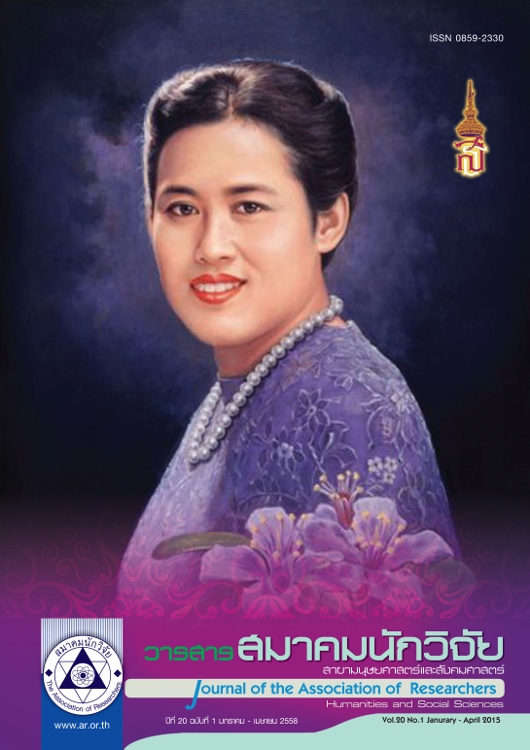Organizational Effectiveness for Implementing the ISO 9001 International Quality Standard in the Industrial and Service Sectors
Main Article Content
Abstract
The main objectives of this study were to examine, to compare, and to analyze factors of the effectiveness of Organizational Management (OM) before and after implementing ISO 9001 international quality standard in the Industrial and Service Sectors (ISS), including presenting the effective appropriate approaches of the OM before and after implementing the ISO 9001 in the ISS. Data of the study, getting from a qualitative set of questionnaires [IOC = 0.824 and Alpha-reliability coefficient = 0.988] were drawn from 300 officers [83.33 percent of multi-stage random sampling technique]. These statistics were analyzed by computing frequency, percentage, means, standard deviation, paired sample t-test, factor analysis, and focus group discussion by experts. Research findings were as follows: 1) As a whole and 8 cateories of effectiveness of the OM, [namely, Customer focus, Leadership, Involvement of people, Process approach, System approach to management, Continual improvement, Factual approach to decision making, and Mutually beneficial supplier relationships], before implementing the ISO 9001 was at the moderate level. Also, after implementing the ISO 9001 was at the high level; 2) After implementing the ISO 9001, all 8 categories of effectiveness of the OM were significant increasingly developed at the .05 level; 3) There were 17 out of 49 variables as crucial issues affecting the effectiveness of the OM after implementing the ISO 9001; and 4) The appropriate approaches with the 4S-RICE model, that had effectiveness on the OM after implementing the ISO 9001, consisted of 8 approaches (crucial projects) for applying after finishing ISO 9001, namely, 1) Self-Evaluation,
2) Increasing Efficiency and Sharing Experience, 3) Research and Evaluation, 4) Strategic Planning, 5) Communication and Relations Building, 6) Self-confidence & Inspiration, 7) Experts & Resources Selection, and 8) Supplier Selection.
Article Details
บทความที่ปรากฏในวารสารนี้ เป็นความรับผิดชอบของผู้เขียน ซึ่งสมาคมนักวิจัยไม่จำเป็นต้องเห็นด้วยเสมอไป การนำเสนอผลงานวิจัยและบทความในวารสารนี้ไปเผยแพร่สามารถกระทำได้ โดยระบุแหล่งอ้างอิงจาก "วารสารสมาคมนักวิจัย"
References
ณัฐพัชร์ ล้อประดิษฐ์พงษ์. (2549). คู่มือสำรวจความพึงพอใจลูกค้า, กรุงเทพมหานคร: ประชุมทอง พริ้นติ้ง กรุ๊ฟ.
พระพรหมคุณาภรณ์ (ป.อ.ปยุตโต, 2546). ความสำคัญต่อการพัฒนาคน พัฒนาประเทศ. กรุงเทพมหานคร: ธรรมสภา.
ภัทรจิตร ครองบุญเรือง. (2548). การประเมินผลการดำเนินงานภายใต้แนวคิด Balanced Scorecard หลังจาก ประยุกต์ใช้ระบบ ISO 9001: 2000. ปริญญานิพนธ์วิทยาศาสตรมหาบัณฑิต สาขาวิชานวัตกรรมอุดมศึกษา บัณฑิตวิทยาลัย มหาวิทยาลัยธรรมศาสตร์
Boiral, Olivier, (2011). “Managing with ISO Systems: Lesson from Practice,” Journal of Long Range Planning, (44): 197-220.
Deming, Edwards W. (1986). Out of the Crisis, Massachusetts: Massachusetts Institute of Technology Center for Advanced Engineering Study.
International Organization for Standardization. (2008). Quality management system requirements: ISO 9001: 2008(E), 4th ed., Switzerland: ISO.
______ (2009). Managing for the sustained success of an organization: A quality management approach. Switzerland: ISO.
Keith, Davis. (1972). Human relations at work, 4th ed., New York: McGraw-Hill.
Millett, John D. (1954). Management in the public service: The quest for effective performance. New York: Mc Graw- Hill Book Company.
Newstrom, J.W., and Devis, K. (1993). Organization behavior: Human behavior at work, 9 th ed., New York: McGraw-Hill.
Robere, Paul J. (2013). Benchmarking a system approach for continual improvement, Bangkok: Robere & Associates (Thailand).
Verma, Harch V. (2012). Services marketing: Text and cases. 2nded., New Delhi: Darling Kindersley.


